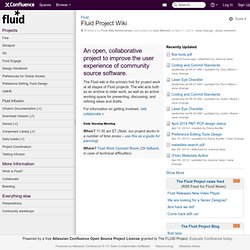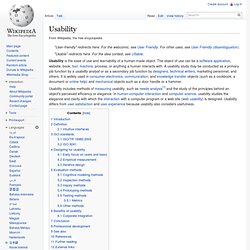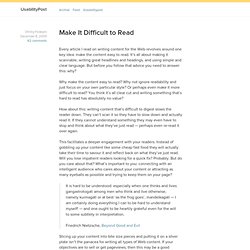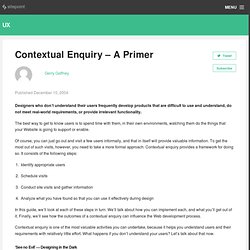

UX Exchange - Q&A site for user experience professionals. Interaction Design Association - Homepage. Fluid Project Wiki - Fluid Project Wiki. The Fluid wiki is the primary hub for project work at all stages of Fluid projects.

The wiki acts both as an archive to older work, as well as an active working space for presenting, discussing, and refining ideas and drafts. For information on getting involved, visit collaborate » Daily Standup Meeting. Dub Projects. Usability. Usability is the ease of use and learnability of a human-made object.

The object of use can be a software application, website, book, tool, machine, process, or anything a human interacts with. A usability study may be conducted as a primary job function by a usability analyst or as a secondary job function by designers, technical writers, marketing personnel, and others. It is widely used in consumer electronics, communication, and knowledge transfer objects (such as a cookbook, a document or online help) and mechanical objects such as a door handle or a hammer. Usability includes methods of measuring usability, such as needs analysis[1] and the study of the principles behind an object's perceived efficiency or elegance.
In human-computer interaction and computer science, usability studies the elegance and clarity with which the interaction with a computer program or a web site (web usability) is designed. Introduction[edit] Definition[edit] Usability is a non-functional requirement. The Difference Between Usability and User Experience. Findability. Findability is a term for the ease with which information contained on a website can be found, both from outside the website (using search engines and the like) and by users already on the website.

Although findability has relevance outside the World Wide Web, it is usually used in the context of the web. Heather Lutze is thought to be the creator of the term in early 2000s.[1] The popularization of the term "findability" for the Web is usually credited to Peter Morville. In 2005 he defined as: "the ability of users to identify an appropriate Web site and navigate the pages of the site to discover and retrieve relevant information resources", though it appears to have been first coined in a public context referring to the web and information retrieval by Alkis Papadopoullos in a 2005 article entitled "Findability"[2][3] Findability encompasses aspects of information architecture, user interface design, accessibility and search engine optimization (SEO), among others.
See also[edit] Make It Difficult to Read. Every article I read on writing content for the Web revolves around one key idea: make the content easy to read.

It’s all about making it scannable, writing great headlines and headings, and using simple and clear language. But before you follow that advice you need to answer this: why? Why make the content easy to read? Why not ignore readability and just focus on your own particular style? Or perhaps even make it more difficult to read? How about this: writing content that’s difficult to digest slows the reader down. This facilitates a deeper engagement with your readers. It is hard to be understood: especially when one thinks and lives gangastrotogati among men who think and live otherwise, namely kurmagati or at best ‘as the frog goes’, mandeikagati — I am certainly doing everything I can to be hard to understand myself!
Slicing up your content into bite size pieces and putting it on a silver plate isn’t the panacea for writing all types of Web content. An introduction to personas and how to create them » Step Two Designs, Tina Calabria. Written by Tina Calabria, published March 2nd, 2004 Categorised under: articles, intranets, usability & information architecture, websites Before embarking on any intranet or website design project, it is important to understand the needs of your users.

It is then possible to identify the features and functionality that will make the intranet or website a success, and how the design can support users with different goals and levels of skill. Findability.org - by Peter Morville. UsabilityPost. The Usability Methods Toolbox - Usability Methods Toolbox Contextual Design Heuristic Evaluation Inspection Inquiry usable engineering. Usability resources for practitioners and managers. Contextual Enquiry - A Primer. Designers who don’t understand their users frequently develop products that are difficult to use and understand, do not meet real-world requirements, or provide irrelevant functionality.

The best way to get to know users is to spend time with them, in their own environments, watching them do the things that your Website is going to support or enable. Of course, you can just go out and visit a few users informally, and that in itself will provide valuable information. To get the most out of such visits, however, you need to take a more formal approach. Contextual enquiry provides a framework for doing so. It consists of the following steps: Identify appropriate users Schedule visits Conduct site visits and gather information Analyze what you have found so that you can use it effectively during design In this guide, we’ll look at each of these steps in turn. ‘See no Evil’ — Designing in the Dark The world of users is messy. UX Booth: User Experience & Usability Blog.